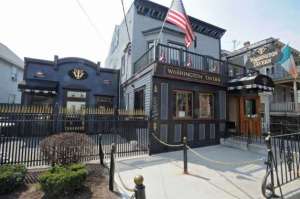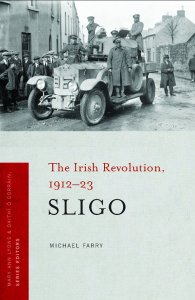 Michael Pearse Byron has been a familiar face on the Irish scene in Albany for many years. Owner of the Washington Tavern and Ginger Man Restaurant on Western Ave., Michael emigrated from Enniscrone, Co. Sligo in 1966, and after working for Schrafft’s Corporation for a few years, settled in Albany and married Patricia Kelley. In 1971, Michael and Pat became the ninth owners of the Washington Tavern, a continuous tavern since 1885, and in 1983 converted the Horton Heating Company office down the block into The Ginger Man Restaurant. Michael returns to Ireland annually, and he and Pat have 3 daughters and 2 grandchildren, Maeve and Fionn.
Michael Pearse Byron has been a familiar face on the Irish scene in Albany for many years. Owner of the Washington Tavern and Ginger Man Restaurant on Western Ave., Michael emigrated from Enniscrone, Co. Sligo in 1966, and after working for Schrafft’s Corporation for a few years, settled in Albany and married Patricia Kelley. In 1971, Michael and Pat became the ninth owners of the Washington Tavern, a continuous tavern since 1885, and in 1983 converted the Horton Heating Company office down the block into The Ginger Man Restaurant. Michael returns to Ireland annually, and he and Pat have 3 daughters and 2 grandchildren, Maeve and Fionn.
 Michael’s father, Charles grew up on a farm in Enniscrone with his parents and four siblings. They had been a farming family for generations. Both Charles and his brother Jack were members of the old IRA. Charles was in the infantry, and Jack was a platoon leader. Jack especially was, as Michael says “a young Turk.” During the War of Independence, the brothers hid weapons in their family home, attended secret drills, slept in safe houses, and were fed by sympathizers. Runners on bicycles would come tell them where to be and when. They were involved in ambushes mostly on the Mayo border.
Michael’s father, Charles grew up on a farm in Enniscrone with his parents and four siblings. They had been a farming family for generations. Both Charles and his brother Jack were members of the old IRA. Charles was in the infantry, and Jack was a platoon leader. Jack especially was, as Michael says “a young Turk.” During the War of Independence, the brothers hid weapons in their family home, attended secret drills, slept in safe houses, and were fed by sympathizers. Runners on bicycles would come tell them where to be and when. They were involved in ambushes mostly on the Mayo border.
 In his book, Sligo: The Irish Revolution, 1912-23, Michael Farry explains that the 1918 Sinn Fein victories in Sligo as elsewhere were a true reflection of the Irish people because for the first time an election in Ireland approached universal suffrage. The Representation of the People Act of 1918 enfranchised all men over 21 and all women over 30, so the electorate in the constituencies of North and South Sligo almost tripled and reflected the voice of the people. Much of Sligo’s early IRA activity in 1919 was social agitation for land redistribution. In late 1920, however, a number of flying columns were formed and the RIC suffered considerable casualties in a number of ambushes. Michael Byron’s father and uncle were part of this activity.
In his book, Sligo: The Irish Revolution, 1912-23, Michael Farry explains that the 1918 Sinn Fein victories in Sligo as elsewhere were a true reflection of the Irish people because for the first time an election in Ireland approached universal suffrage. The Representation of the People Act of 1918 enfranchised all men over 21 and all women over 30, so the electorate in the constituencies of North and South Sligo almost tripled and reflected the voice of the people. Much of Sligo’s early IRA activity in 1919 was social agitation for land redistribution. In late 1920, however, a number of flying columns were formed and the RIC suffered considerable casualties in a number of ambushes. Michael Byron’s father and uncle were part of this activity.
Two ambushes Michael remembers hearing about were the Ardnaree Ambush in Ballina in July 1920, and the Culleens Ambush on the Sligo to Ballina road on July 1, 1921. Michael’s father, Charles was wounded in one of the ambushes and spent time in St. Bricin’s Military Hospital in Dublin. He received an IRA medal for his service.
Years later when Charles married Cecelia Doherty and had Michael and his 5 siblings, he spoke very little about the war years, but he received a 7 pound pension for the rest of his life and remained a “died in the wool” Fianna Fail man. Michael heard of his father’s exploits from his mother.
Here are two first-hand accounts of the ambushes the Byron brothers were involved in. The first is an account of a witness to the Ballina ambush, and the second is a newspaper article about the Culleens ambush:
Statement of Stephen Donnelly
Ballina and its troubled Times, blog by P.J.Clarke:
29 July 1920:
One RIC man was killed and one wounded in an IRA ambush in Ballina, County Mayo
“In the month of July 1920, the R.I.C. used to patrol the town in batches of four six and eight. At a meeting attended by Tom Ruane, Brigade Commandant; Frank Flynn, Battalion O/C.; I and a few others decided to ambush them and collect their arms. A few nights later, an R.I.C. patrol of one sergeant, two constables and a Tan appeared on patrol. We decided to ambush them at the Moy Lane on their return to the barracks. We took up positions. Frank Flynn, Jack Jordan, Willie Lydon and I were at the mouth of the lane. The remainder of the party on the opposite side of the street in another laneway. When the patrol came opposite our party they got the order to put up their hands. The party on the opposite side of the street closed in immediately. The Tan pulled his gun and started to fire. Fire was exchanged with our party on the street. We pulled the sergeant and another constable into the lane and again shouted to them to put up their hands. The constable immediately did so, but the sergeant made an attempt to pull his gun. I immediately fired and he fell. We disarmed the two of them; the third man was disarmed in the street, but the Tan got away up the street. We were hardly away when more R.I.C. came from the barracks firing wildly through the town.”
Article in The Western People, July 7, 1921
Two Policemen Show Dead Near Dromore West
FIierce Mountain Fight
1 July 1921: “Culleens … was on last Friday the scene of one of the most sensational ambushes yet recorded in the West. Two policemen—Constables King and Higgins—were shot dead as a result of the tragic affair, and another Constable Curley, was seriously wounded.
The ambush occurred at a point where the road runs high above the level of the surrounding country, and almost equi-distance between the sea and the Ox mountains. From the mountains to the road there stretches a wide expanse of bog … Just above the point where the ambush occurred there stand a public house, known as Culleens Inn, now occupied by a family named Tuffy. In the early hours of Friday morning two strange young men, fully armed, walked into this place, and at the point of a revolver compelled Mr. P. Tuffy, a son of the proprietor, who manages the business for his father, to hand over all the money in the house—a sum, it is stated, of about £300. They afterwards decamped as suddenly as they appeared. Young Mr. Tuffy subsequently made with all speed for Dromore West police barracks, about five miles away, where he reported the matter, and a cycling patrol, consisting of seven policemen, was detailed to investigate it.
They left Dromore West about 11.30 a.m. [and] had almost reached their destination when they ran into the ambush. The ambushers, who numbered about thirty, were divided into two parties. Constables King and Higgins … were allowed to pass the first party, but fire was immediately opened on the second and third ranks of the patrol. Before they could take cover, Constable Curley fell, wounded in both arms. Meanwhile Constable King and Higgins were surrounded by the second party of ambushers, relieved of their arms, and taken prisoners. Lower down the road a lively fight was proceeding between the four remaining constables and the first section of the ambushers.
… at 3 p.m. … three lorries conveying constabulary reinforcements from Castlebar passed through the town on their way to the scene of the conflict … Meanwhile reinforcements from Easkey and Dromore West arrived and got into touch with the retreating ambushers.
A running fight of the fiercest description ensued across the bogs, and it was about this time that the two captured constables, King and Higgins, met their death. Exact details … are not available, but one account states that the Constables, finding their captors closely engaged by the pursuing forces, made a dash for liberty, and were thereupon fired upon by their guards. One of the constables was killed instantaneously, but it is stated that the other was alive when found by his comrades and lived long enough to receive the last rites of the church from a priest who was brought to him with all haste …
The fight afterwards continued with the fiercest intensity, and an effort was made to surround the rebels, a strong force being sent through Bonniconlon to the Gap to try to take them in the rear, but the attempt proved unavailing. No longer encumbered by their two captives, the rebels disappeared into the mountain … with great rapidity and successfully evaded pursuit. During the fight the police state a number of the ambushers were seen to fall, and they believe some of them were killed. At the time of writing however, no dead bodies, except those of the constables, had been found in the bogs. A large number working in the bog during the fight … [were] caught between two fires … and sought refuge in bogholes, trenches or wherever they could find adequate cover. It is rumoured that a party of C.D. Board workmen operating in the district were compelled to assist in the pursuit, and although unarmed had to go on in front of one section of the pursuing forces. Several horses and cattle who got in the line of fire were killed. The bodies of the two dead constables, who were both Catholics, and native of County Galway, were conveyed in the evening to Dromore West barracks, where it is understood, a military inquiry concerning the affair will be held.
On the same evening. Mr. Tuffy, the young man who reported the robbery, was taken into custody. … a suspicion that the robbery was only a ruse to lure them into a prepared ambush. Mr. Tuffy, who has never been identified with any political organisation, appears, however, to have acted quite innocently in the matter … He has been removed to Sligo jail.
On Saturday Crown forces, consisting of Auxiliaries, military and police, again conducted a thorough search of the locality but without result. The occurrence, the first of its kind in the district, has given rise to a feeling of the greatest tension, and the people of the surrounding country are considerably alarmed.”
